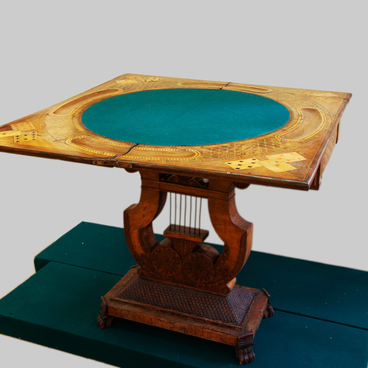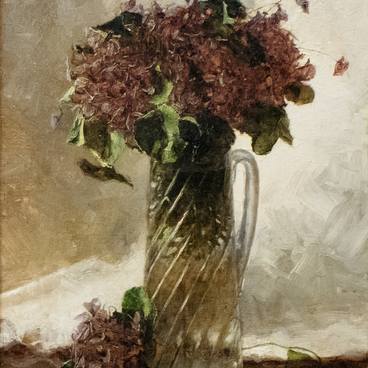In the 19th century, authors of portraits similar to this one did not normally seek to convey all the subtleties of the character of the depicted person. The key goal of the artist was to portray the main status symbols and symbolic attributes of the painting’s subject. Among other techniques, this involved experiments with different ways of positioning the model on the canvas, as well as with various poses and gestures.
In the portrait on display, Pyotr Talyzin is seated sideways to the viewer, with his face only visible thanks to a slight turn of his head. He looks as if he was distracted from a business conversation or small talk for a brief moment. The subject of the portrait has light-eyes, neatly styled brown hair, and luxurious fluffy sideburns. In Russia, this style of sideburns was known as the senatorial sideburns and was highly popular during the 19th century.
Talyzin’s outfit is strict and simple. This allows to shift the viewer’s focus to the image of the portrait’s subject, the high society socialite.
In 1849, Pyotr Talyzin graduated from Moscow University with a degree of an Actual Student. He served as a member of the KutaIsi District Court (Kutaisi is one of the most significant historical and economic centers of western Georgia).
Pyotr Alexandrovich (1828–1897) was the second son of Alexander Stepanovich and Olga Nikolaevna Talyzins. He grew up with his brothers and sisters in the Talyzin Denezhnikovo estate.
The Russian State Archive of Ancient Acts holds hundreds of documents related to the Talyzin family. These include the childhood diaries of Pyotr and Stepan Talyzins. The diaries contain descriptions of their lives both in Moscow and outside the city: in Denezhnikovo and other estates.
The Talyzin estate is situated in Denezhnikovo, which is part of present-day Ramensky District in the Moscow Region. It was built in the second half of the 18th century by Ivan Lukyanovich Talyzin and his nephew Alexander Fyodorovich Talyzin.
The Talyzin family of noblemen of ancient standing originates from murza Kuchuk Tagaldy-zin, also known as Tagai-Eldiz. In 1436, he left the Golden Horde for Murom to serve Grand Duke Vasily Vasilyevich.
Throughout the whole 19th century and the early 20th century, the estate was owned by the Talyzin family. After the nationalization, the estate was repurposed to house a Young Pioneer camp, before becoming abandoned. Today, this monument of early classical architecture and the art of landscape gardening lies in ruins.
In the portrait on display, Pyotr Talyzin is seated sideways to the viewer, with his face only visible thanks to a slight turn of his head. He looks as if he was distracted from a business conversation or small talk for a brief moment. The subject of the portrait has light-eyes, neatly styled brown hair, and luxurious fluffy sideburns. In Russia, this style of sideburns was known as the senatorial sideburns and was highly popular during the 19th century.
Talyzin’s outfit is strict and simple. This allows to shift the viewer’s focus to the image of the portrait’s subject, the high society socialite.
In 1849, Pyotr Talyzin graduated from Moscow University with a degree of an Actual Student. He served as a member of the KutaIsi District Court (Kutaisi is one of the most significant historical and economic centers of western Georgia).
Pyotr Alexandrovich (1828–1897) was the second son of Alexander Stepanovich and Olga Nikolaevna Talyzins. He grew up with his brothers and sisters in the Talyzin Denezhnikovo estate.
The Russian State Archive of Ancient Acts holds hundreds of documents related to the Talyzin family. These include the childhood diaries of Pyotr and Stepan Talyzins. The diaries contain descriptions of their lives both in Moscow and outside the city: in Denezhnikovo and other estates.
The Talyzin estate is situated in Denezhnikovo, which is part of present-day Ramensky District in the Moscow Region. It was built in the second half of the 18th century by Ivan Lukyanovich Talyzin and his nephew Alexander Fyodorovich Talyzin.
The Talyzin family of noblemen of ancient standing originates from murza Kuchuk Tagaldy-zin, also known as Tagai-Eldiz. In 1436, he left the Golden Horde for Murom to serve Grand Duke Vasily Vasilyevich.
Throughout the whole 19th century and the early 20th century, the estate was owned by the Talyzin family. After the nationalization, the estate was repurposed to house a Young Pioneer camp, before becoming abandoned. Today, this monument of early classical architecture and the art of landscape gardening lies in ruins.



